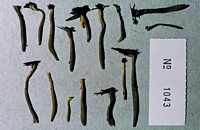|
 Ramariopsis aurantioolivacea Ramariopsis aurantioolivacea
BiostatusPresent in region - Indigenous. Endemic
Images (click to enlarge)
Caption: 1043, id. R. Petersen, label 50x10mm, NZ, NI, Orere, Te Morehue, on soil among litter under
Leptospermum-Knightia-Suttonia, 04.07.1981, leg. EH
Owner: E. Horak |
Article: Petersen, R.H. (1988). The clavarioid fungi of New Zealand. New Zealand Department of Scientific and Industrial Research, Bulletin 236: 170 pp. Wellington:.
Description: Fruit bodies up to 3.5 cm high, up to 2.5 mm thick, fusiform.simple clubs, gregarious, arising from small, white, mycelial patches. Club fusiform, tapering upward somewhat, olive ("buffy citrine") to yellowish olive ("chaetura-drab"., "orange-citrine", "citrine¬drab", "citrine", "light brownish olive", "deep olive"), opaque; apex rounded, often green ("olive-green", "diamine-green") to concolourous with club ("serpentine-green"), in age fading to "raw-sienna"; flesh whitish to yellow. Stipe tapering downward somewhat, pale green when young ("sea-foam green"), then yellowish ("cream-buff", "colonial-buff"), bright greenish yellow ("old gold", "primuline-yellow"), and finally golden yellow ("ferruginous", "cadmium-yellow", "light orange-yellow"), or dull orange ("Mars-yellow", "xanthine-orange"), subglabrous. Taste and odour unrecorded.
Macrochemical reactions: FCL on hymenium causes loss of olive colour to yellow; tissue in 2% KOH solution turns bright golden yellow.
Tramal hyphae up to 12 p.m diam., not significantly inflated, thin-walled, clamped, hyaline, parallel, free. Subhymenium poorly developed. Hymenium thickening; basidia 60-70 x 7-8 gm, attenuate-clavate, clamped; contents multiguttulate when mature; sterigmata 4, stout, straight, divergent.
Spores (Fig. 117) 5.4-6.5 x 3.6-5.0 gm (E =1.07-1.64; E'° =1.40; L'" = 5.96 gm), ovate to subglobose, flattened adaxially, white in prints, smooth, thin-walled; contents opalescent to uniguttulate when mature; hilar appendix stout, up to 2 gm long, conical.
Notes: Except for fruit body colour, this is virtually identical to Ramariopsis depokensis (van Over.) Pet., on which I have reported previously (Petersen 1979,1980). I have been tempted, therefore, to describe it as a variety of that species, especially because R. depokensis ranges throughout the Pacific to Tierra del Fuego (Petersen, unpublished data). Conversely, R. laeticolor (Berk.) Pet. differs from R. depokensis only in spore dimensions, and if all three are taken together, one might conclude that a species complex could be delineated. I think it best, therefore, to propose a new species epithet for this olive form, limited as it seems to New Zealand.
The nature of pigmentation in Ramariopsis is not known, but the colour changes from olive to yellow in FCL and dilute KOH should give some clue.
|